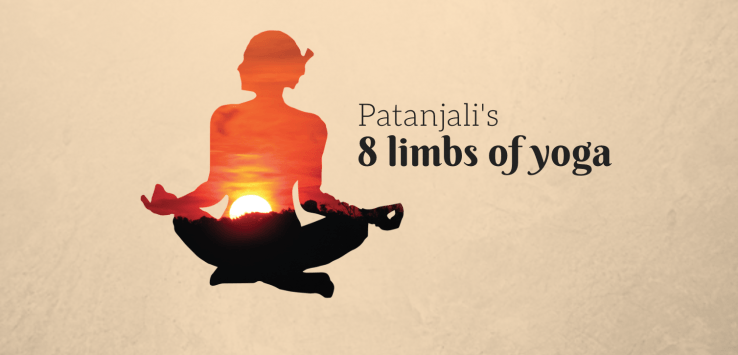- 1. Moral Virtues (Yamas)
- 2. Personal Rules (Niyamas)
- 3. Yoga Postures (Asanas)
- 4. Breath Control (Pranayama)
- 5. Withdrawal of the Senses (Pratyahara)
- 6. Concentration (Dharana)
- 7. Meditation (Dhyana)
- 8. Divine Union (Samadhi)
Thousands of years ago, people in the Indian subcontinent began practising yoga. During those years, the wisdom and techniques of yoga were scattered across many texts. A great sage of that era named Patanjali realised that compiling all yoga’s profound knowledge into one manual would be of huge help to mankind. So, he wrote 196 “sutras” or aphorisms that came to be known as Patanjali’s sutras. Patanjali’s sutras capture yoga’s essence and logically lay out the path of Ashtanga yoga, made up of 8 parts (“Ashtanga” translates to “8 parts”). The 8 limbs of yoga bring us a life of bliss and wellness – on the physical, mental and spiritual levels.
The 8 Limbs of Yoga – Steps towards a Blissful Life
1. Moral Virtues (Yamas)
The first step in the path of Ashtanga yoga lays out 5 morals while interacting with people. They are valuable ways to purify and strengthen our minds, as well as improve the quality of our lives. They are:
- Non-violence ad compassion for all living beings
- Honest and kind communication
- Non-stealing, which also includes others’ time!
- Control over sexual energy
- Letting go of the desire for hoarding things
2. Personal Rules (Niyamas)
The next step in the sutras of Patanjali is to follow 5 rules when it comes to how we treat ourselves. They’re great ways to develop wellness of the body and mind. They are:
- Maintaining a clean body and mind
- Being content with and accepting what we have
- Discipline in actions like eating, doing asanas and body posture
- Developing self awareness in everything we do
- Surrendering to and seeking guidance from the Creator
3. Yoga Postures (Asanas)
The most popular and widely followed among the 8 limbs of yoga! Asanas or yoga postures are not just exercise. They’re tools to develop a range of abilities…like concentration, balance, physical strength, mental alertness and clarity, control over emotions, and a strong will. The special thing about asanas is that they unite the body and mind. What happens when the body and mind are in perfect harmony? Well, a lot. Yoga looks at the body as not just a vehicle for the soul, but also as a treasure chest of wisdom. With asanas, you can better listen to your body’s needs and messages. You begin to build the much-needed foundation for physical, emotional and spiritual wellness.
4. Breath Control (Pranayama)
Another popular practice, Pranayama is all about controlling and directing “Prana” or life force using the breath. There are tons of benefits to the nervous, respiratory, circulatory, digestive and other systems. It balances the vital energies, opens and cleanses the chakras, balances the doshas, develops higher focus and self discipline, and works wonders for overall health. Breath control goes pretty much hand in hand with asanas. With mastery over the breath, you’re ready for the next step…
5. Withdrawal of the Senses (Pratyahara)
During this step of the journey, the yogi lets go of attachment towards materials that serve the senses, like food cravings and sensual demands. This leads to a state where nothing in the outer world can distract your mind or throw your emotions off balance. With heightened ability to focus and sharpened senses, the yogi is just 3 more steps away from enlightenment.
6. Concentration (Dharana)
This step develops unbreakable concentration – the yogi can fix his or her mind on anything, and focus on it as long as desired. Sounds incredible? We think so! Dharana involves picking an object, like a mantra or part of the body…and directing the entire attention on it. This unleashes the mind’s immense power.
7. Meditation (Dhyana)
Meditation, contemplation and worship make up this stage. The yogi concentrates on and contemplates about the divine. The idea behind this is that when you contemplate about something with a pure and perfectly concentrated mind, you’re able to realise its true nature. So understanding this, the yogi sets out to understand the truth about the divine – and therefore his or her own self.
8. Divine Union (Samadhi)
The last among the 8 limbs of yoga is union with the divine…where the ego dissolves and you enter a state of freedom from suffering and eternal bliss! This is the ultimate aim of yoga.






Leave a Reply